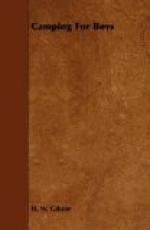Arrows are divided into three parts: the head, sometimes called the pile, the shaft and the feathers. The shaft is generally made of hickory, ash, elm or pine, and its length is dependent upon that of the bow. For a five-foot bow, make the length two feet and the width and thickness about one-half inch. For target practice a wire nail driven into the end of the pile, as shown on page 227, with the head of the nail filed off and pointed, makes an excellent head. Feathering is the next operation. Turkey and goose feathers are generally used. Strip off the broader side of the vane of three feathers and glue them to the shaft one inch and a quarter from the notch, spacing them equally from each other. One feather should be placed at right angles to the notch. This is known as the cock feather and should always point away from the bow when the arrow is shot.
Archery
The rules for the five essential points are these:
Standing: In taking position to draw the bow, the heels must be seven to eight inches apart, feet firm on the ground, yet easy and springy, not rigid.
Nocking: This is manipulating the bow string. Hold the string with two fingers and the arrow between the first and second fingers. Grip firmly, but not so as to give awkwardness to any finger.
Drawing: In drawing stand with the left shoulder toward the target, turning the head only from the neck and looking over the left shoulder. Then raise the bow with the left hand, keeping the upper end inclined one or two degrees from the body. With the right hand draw the arrow to chin-level and below the ear.
Holding: Steady the aim a moment and keep the point of aim directly in view, looking along the whole length of the arrow.
Loosing: In letting the arrow go, do not jerk, but loose smoothly, and be certain your bow arm does not move when loosing. To get a clean, sharp loose is more than half way to hitting the target.
BIBLIOGRAPHY
Indoor and Outdoor Game.(188)—A. M. Chesley. American Sports Publishing Co.
An Athletic Primer, Group XII., No. 87—J. E. Sullivan. American Sports Publishing Co.
Official Handbook Y. M. C. A. Athletic League, Group XII., No. 302.—American Sports Publishing Co. Tether Tennis, Volley Ball, Etc., No. 188.—American Sports Publishing Co.
The above booklets are published at 10 cents each, and should be in the hands of every camp leader, also the latest guides in Baseball and Tennis.
At Home in the Water—George H. Corsan. Association Press, 75 cents. Twenty pages of this excellent book are devoted to water sports, and it also contains complete rules for Water Polo, a splendid game for adults, but unwise to play in a boys’ camp.
The Birch Bark Roll—Ernest Thompson-Seton. Doubleday, Page & Co., 25 cents.
Two Little Savages—Ernest Thompson-Seton. Doubleday, Page & Co., $1.75.




